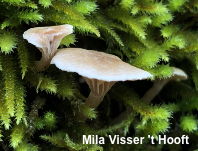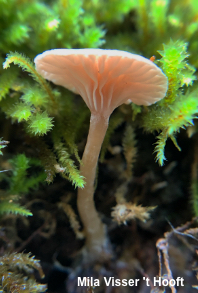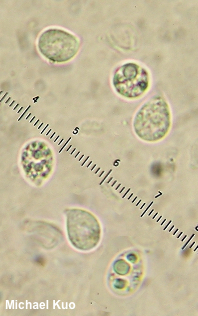| Major Groups > Gilled Mushrooms > Pale-Spored > Omphalinoid > Lichenomphalia umbellifera |

|
Lichenomphalia umbellifera [ Basidiomycota > Agaricales > Hygrophoraceae > Lichenomphalia . . . ] by Michael Kuo This little mushroom features a pale brown to yellowish, grooved cap, and pale, distant gills that run down the stem. It is found on moss-covered logs and on soil, growing alone or in little troops. The spore print is white and, under the microscope, the spores are ellipsoid and inamyloid. Lichenomphalia umbellifera is like the ur-omphalinoid mushroom, since it was first officially described by Linnaeus (1753), who thought it looked like a tiny parasol. Linnaeus said the species grew among rotting leaves, but if he had looked very closely under the leaves he might have seen that the mushrooms grow in association with a green alga. This kind of partnership is what constitutes a lichen, and Lichenomphalia umbellifera is, indeed, a lichen—one that produces a gilled mushroom. When mushrooms are not being produced, the lichen is inconspicuous, dark green, and crust-like. A 2012 study (Geml and collaborators) found "no significant genetic differentiation among conspecific North American and Eurasian populations in Lichenomphalia," supporting the idea that Lichenopmhalia umbellifera is distributed worldwide—although the researchers found northern and southern "lineages" within the species. Omphalina ericetorum and Omphalina umbellifera are synonyms, as are ericetorum and umbellifera combinations in various other genera, including Phytoconis. Thanks to Mila Visser 't Hooft for documenting, collecting, and preserving Lichenomphalia umbellifera for study; her collection is deposited in The Herbarium of Michael Kuo. Description: Ecology: Mutualistic with a green alga (a Coccomyxa species), forming a lichen; mushrooms growing alone or gregariously on soil, in moss, or on decaying conifer wood; spring through fall, or over winter in warm climates; originally described from Europe; in North America widely distributed in northern and montane areas; also recorded in Oceania. The illustrated and described collection is from California. Cap: 2.5 cm across at maturity; planoconvex; lubricous; bald; dull yellowish to dull brownish; margin lined, becoming wavy. Gills: Running down the stem; distant; thick and waxy; whitish to yellowish; short-gills present near cap margin. Stem: 3 cm long and about 4 mm thick at maturity; equal; moist; bald or nearly so, but with a fuzzy base; pale brownish to pale yellowish. Flesh: Thin; whitish; unchanging when sliced. Odor: Not distinctive. Microscopic Features: Spores 7–10 x 5–7 µm; ellipsoid to widely lacrymoid; smooth; hyaline in KOH; inamyloid. Basidia 4-sterigmate; 35–45 x 5–7 µm; subclavate. Cystidia not found. Pileipellis a cutis of hyaline to brownish, smooth elements 4–10 µm wide. Clamp connections not found. REFERENCES: (Linnaeus, 1753) Redhead, Lutzoni, Moncalvo & Vilgalys, 2002. (Bigelow, 1970; Smith, 1975; Redhead & Weresub, 1978; Smith, Smith & Weber, 1979; Phillips, 1981; Arora, 1986; Breitenbach & Kränzlin, 1991; Phillips, 1991/2005; Schalkwijk-Barendsen, 1991; Lincoff, 1992; Kuyper, 1995; Barron, 1999; Brodo et al., 2001; Redhead et al., 2002; Laursen & Seppelt, 2009; Trudell & Ammirati, 2009; Buczacki et al., 2012; Geml et al., 2012; Desjardin, Wood & Stevens, 2015; Siegel & Schwarz, 2016; Baroni, 2017; Gminder & Böhning, 2017; Elborne, 2018; Læssøe & Petersen, 2019.) Herb. Kuo 01262001. This site contains no information about the edibility or toxicity of mushrooms. |
© MushroomExpert.Com |
|
Cite this page as: Kuo, M. (2020, September). Lichenomphalia umbellifera. Retrieved from the MushroomExpert.Com Web site: http://www.mushroomexpert.com/lichenomphalia_umbellifera.html |


